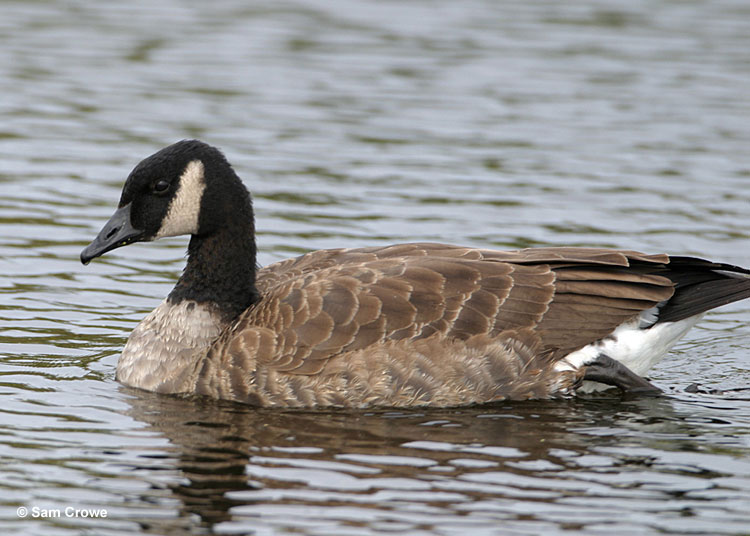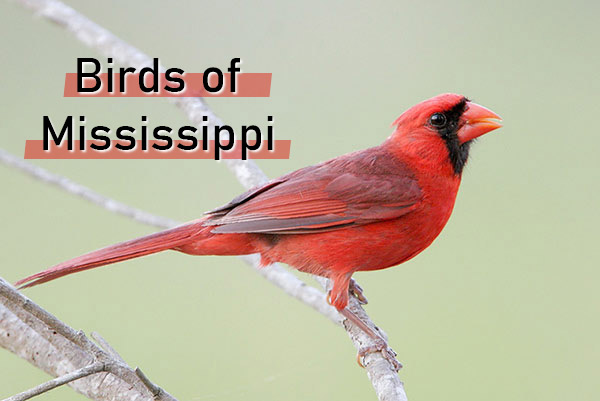
Mississippi is a southern state with a warm climate and 48,430 square miles of cypress swamps, hardwood forests, farm fields, and wetlands.
These beautiful habitats are home to more than 425 birds in Mississippi including eye-catching species like the Painted Bunting and the graceful Mississippi Kite!
Even better, lots of birds are easy to see in Mississippi, especially in wildlife preserves and national wildlife refuges.
Instead of making a bird list based on guessing, we used real, up to date data.
Sadly, the extinct Carolina Parakeet couldn’t be saved in time and the magnificent Ivory-billed Woodpecker is likely gone from the state but most birds are still common.
You don’t have to go far to see many of those birds either. A lot live in backyards and habitats close to home!
We bet you have seen a lot of those birds but were you able to identify all of them? This list of common backyard and wild birds of Mississippi will help!
On this page
- Most Common Birds In Mississippi
- Northern Cardinal
- Blue Jay
- Carolina Wren
- Northern Mockingbird
- Red-bellied Woodpecker
- Carolina Chickadee
- Mourning Dove
- Tufted Titmouse
- Eastern Bluebird
- Downy Woodpecker
- Great Blue Heron
- Red-winged Blackbird
- American Crow
- House Finch
- Yellow-rumped Warbler
- Great Egret
- Eastern Towhee
- Brown Thrasher
- American Robin
- European Starling
- Turkey Vulture
- Laughing Gull
- Fish Crow
- White-eyed Vireo
- Double-crested Cormorant
- Osprey
- White-throated Sparrow
- Pine Warbler
- Canada Goose
- Killdeer
- Ruby-throated Hummingbird
- Eastern Phoebe
- Blue-gray Gnatcatcher
- Brown Pelican
- House Sparrow
- FAQ
Most Common Birds In Mississippi
Which are the most common birds in Mississippi?
Instead of making a bird list based on guessing, we used real, up to date data.
To make a list we can trust, we reviewed the latest eBird data to show the most frequently seen species in Mississippi. Then, we ordered those birds from most common to least common.
To help recognize those species, we also included key information about their behavior and identification.
Keep in mind that the birds at the end of the list are common and easy to see too!
Northern Cardinal
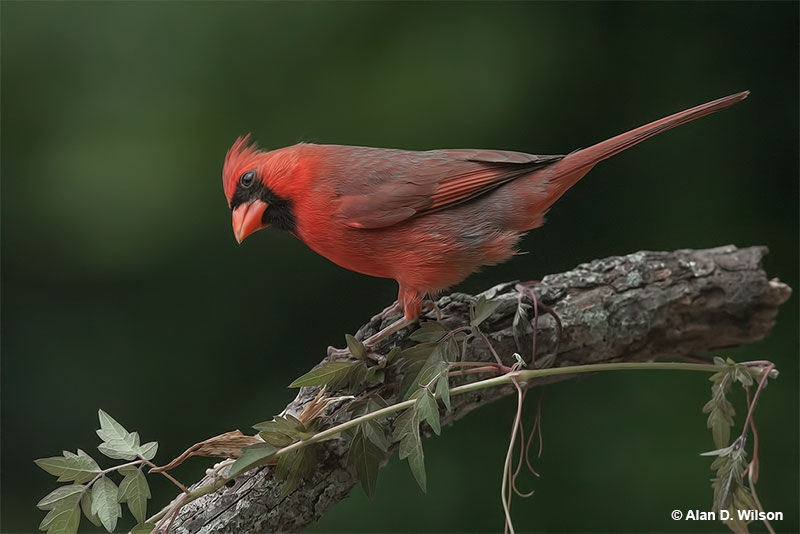
Scientific name: Cardinalis cardinalis
Length: 8.75 inches
Weight: 1.6 ounces
Wingspan: 12 inches
Song: “pichew-pichew-pichew, chew,chew,chew,chew,chew”
Northern Cardinals are medium-sized songbirds with a perky crest and big orange-red beak. Males are bright red with a black throat and face, and have dusky red on their back, wings, and tail.
Female Northern Cardinals are grayish-brown and buff with some black on their face and throat. They also have red highlights in their crest, wings, and long, rounded tail.
This species has short, rounded wings and seems to bounce up and down as they move through the air. In flight, Northern Cardinals also make sharp chip notes.
The Northern Cardinal is a bird of second growth, gardens, and parks. It eats seeds, insects, and some fruit and is a regular visitor to bird feeders. They forage on and near the ground but males sing from a prominent perch.
This beautiful bird occurs in pairs and nests in bushes and low trees. It is common in the eastern and southwestern USA, southern Ontario, and in Mexico.
Key Identifications:
- Crested bird with a conical orange-red beak and a black face. Males are red, females are grayish-brown and buff.
- Forages for seeds and insects on and near the ground.
- Makes a cup-shaped nest in bushes and low trees.
- Sings a clear, whistled song of repeated notes. They can sound like “cheer, cheer, chew, chew, chew, chew” or a quick “birdee,birdee,birdee,birdee,birdee“. They also make loud, sharp chip notes.
Northern Cardinals are one of the most beautiful common birds in most states, including Mississippi. It’s no wonder seven different states chose it to be their official bird. Another fun fact about this species is that female Northern Cardinals also sing. They sing while sitting on the nest and may do so to tell their mates to bring food or warn them about predators.
Blue Jay
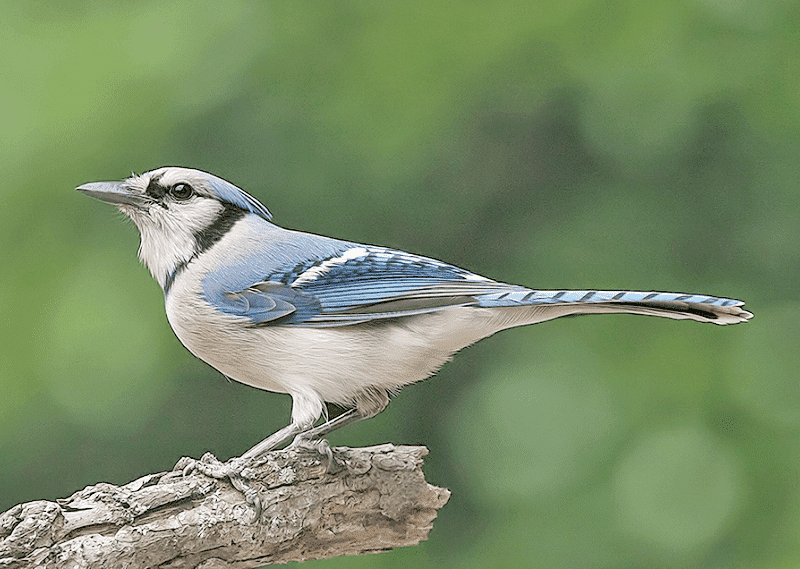
Photograph © Alan Wilson.
Scientific name: Cyanocitta cristata
Length: 11 inches
Weight: 3 ounces
Wingspan: 16 inches
Song: “Nyeah! Nyeah! Nyeah!”
The Blue Jay is a fairly large, crested bird with a straight black bill. Both sexes look alike and are blue above and gray and white below. They also have some small black lines on their faces and a narrow black necklace that goes up to the side of their face and crest.
Blue Jays also have some white markings and black barring in their wings and on their tail. Young birds look like adults but are duller blue.
They make messy cup nests at various heights in a variety of trees.
These social and intelligent birds feed on acorns, nuts, insects, and other small creatures. Like other members of the jay and crow family, they eat the eggs and nestlings of other birds.
The Blue Jay is a common bird of woodlands, forest, and towns east of the Rocky Mountains in the USA and central and southern Canada.
Key Identifications:
- Crested, fairly large bird with bright blue above and gray below.
- Feeds in trees and at feeders. Eats acorns, nuts, insects and many other food items.
- Makes a messy cup nest of sticks in a tree.
- Very vocal. In flight, Blue Jays often call as they swoop through the trees. They make a variety of sounds and mimic some other birds. Common calls include a nasal and complaining “Nyeah! Nyeah! Nyeah!” and various whistled calls.
The Blue Jay is a common, intelligent, and noisy bird. They make their presence known with their loud calls and can visit feeders. Ironically, when communicating with each other at close quarters, this species makes much softer and quieter calls. It’s almost as if they are talking with each other!
Carolina Wren
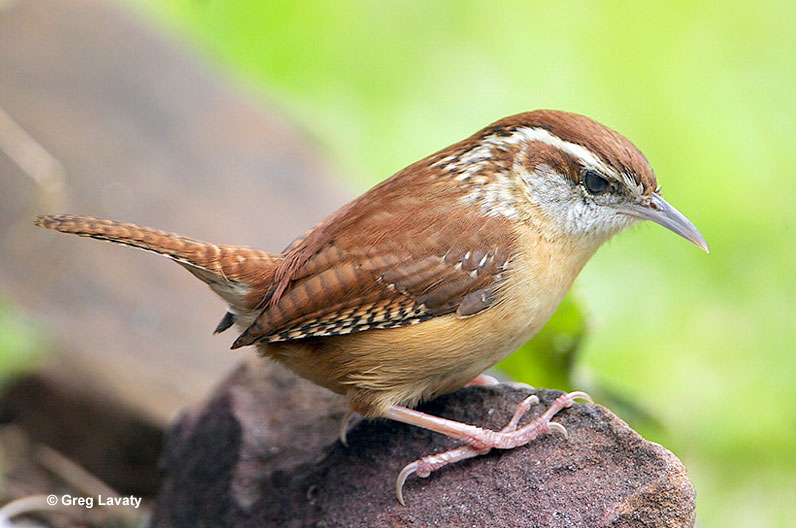
Scientific name: Thryothorus ludovicianus
Length: 5.5 inches
Weight: .74 ounces
Wingspan: 7.5 inches
Song: “teakettle, teakettle, teakettle”
The Carolina Wren is a small, reddish-brown and buff bird with a long, sharp, slightly decurved beak. It has a long, narrow, white eyebrow, a white throat, and some white mottling on its face. Males and females are similar and have black barring on their short wings, long tail, and under the tail.
Juveniles are similar but have paler underparts. This animated and vocal little bird forages for bugs in vine tangles and other dense vegetation. It usually occurs in pairs that can easily hide in the dense vegetation they prefer.
Carolina Wrens build a domed, cup nest made of sticks and soft vegetation. There is a side entrance and it can be placed in cavities and crevices of stumps, bushes, trees, potted plants, and other structures.
The Carolina Wren lives in vegetated gardens, second growth, parks and similar habitats in much of the eastern USA, parts of southern Ontario, and parts of eastern Mexico.
Key Identifications:
- Small reddish-brown and buff bird with a long beak and long white eyebrow.
- Feeds on arthropods in dense, tangled vegetation.
- Makes a domed cup nest with a side entrance in crevices, tree cavities, and human-made structures.
- Carolina Wrens fill the garden with loud and melodious songs. One common song sounds like, “teakettle, teakettle, teakettle“. They also make trilled sounds and harsh, nasal calls.
The Carolina Wren is a vocal species of gardens and second growth. Pairs use their long beaks to catch bugs and insects and aren’t shy about nesting near people. Many of these friendly birds have nested in such places as old shoes, potted plants, and abandoned cars.
Northern Mockingbird
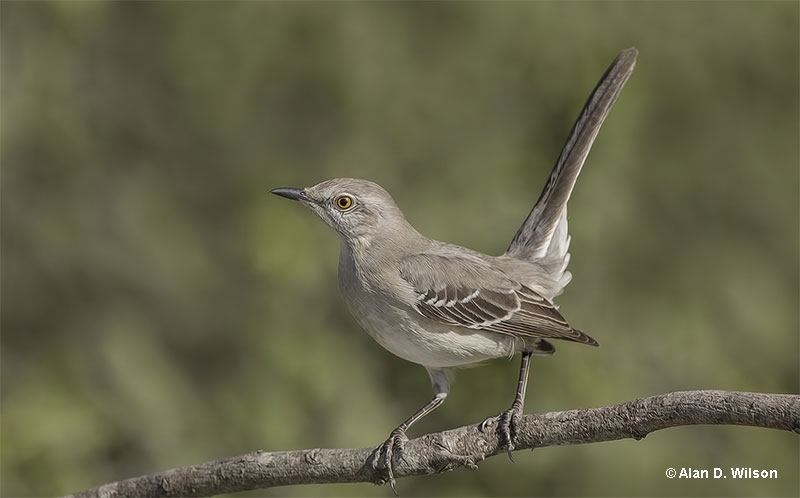
© Alan D. Wilson
Scientific name: Mimus polyglottos
Length: 10 inches
Weight: 1.7 ounces
Wingspan: 14 inches
Song: “kerdee, kerdee, kerdee…jirdle,jirdle,jidrle…”
The Northern Mockingbird is a state bird of Mississippi! A pale gray and white bird with a long tail. Around the same size as an American Robin, it has a dark line through a pale eye, a short, slender beak, and two white wing bars.
Both sexes look alike, are gray above, and white and buff below. In flight, this bird shows a blackish tail with white outer feathers and a big white wing patch.
Northern Mockingbirds feed on insects and berries. They forage in open grassy spots, on the ground. These animated birds run and pick bugs from the ground and fly up to catch insects in flight. In winter, they also perch in bushes to feast on berries.
The Northern Mockingbird lives in towns, parks, and other semi-open habitats, and builds cup nests in bushes and low trees. Northern Mockingbirds are common garden birds in much of the eastern and southern USA, southern Ontario, and Mexico.
Key Identifications:
- Vocal, gray and white bird with a small bill, white wing patches, and a long, black and white tail.
- Feeds on the ground in open areas and in bushes. Mostly eats insects and berries.
- Makes a cup nest in a bush or low tree.
- Very vocal. Sings many phrases and mimics many other birds. Some of the more regular phrases sound like, “kerdee, kerdee, kerdee…jirdle,jirdle,jidrle…“. These are interspered with the calls of Blue Jays, woodpeckers, Tufted Titmouse, and various other bird species.
The Northern Mockingbird is a common and conspicuous bird. They are often seen on lawns and sing from rooftops. This species can mimic the calls of 35 bird species as well as mechanical sounds. More than a century ago, these avian virtuosos were highly prized as a cagebird and were traded for large sums of money.
Red-bellied Woodpecker
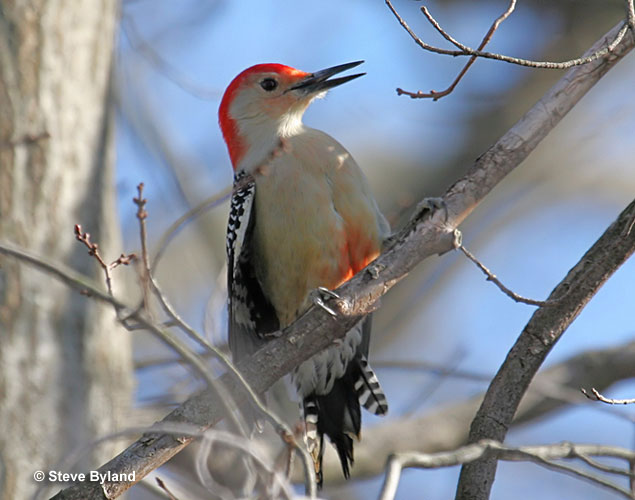
Scientific name: Melanerpes carolinus
Length: 9.25 inches
Weight: 2.2 ounces
Wingspan: 16 inches
Song: “Qwerr!”
Red-bellied Woodpeckers are medium-sized with black and white barring on their back and wings. They have a long beak and pale gray underparts with a small red patch on the belly.
Males have red on the head from the bill to the back of the neck (the nape). Females have an orange-red spot above their bill and red on the back of their head. Both sexes have a mostly white rump and central tail feathers.
This woodpecker species has long wings and “undulating” flight where it moves up and down as it flies. In flight, Red-bellied Woodpeckers show a small white patch in their wings.
The Red-bellied Woodpecker lives in wooded habitats. It eats nuts, seeds, insects, fruit, and can attack nestlings of other species. It also visits bird feeders.
This striking woodpecker occurs in pairs and nests in tree cavities high above the ground. It is common in the eastern USA and parts of southern Ontario.
Key Identifications:
- Grayish woodpecker with black and white barring above, and red on the top of the head and back of the neck.
- Forages for seeds, nuts, insects and other food on trunks and branches.
- Nests in a tree cavity, high overhead.
- Makes a loud exclamation, “Qwerr!“. It also makes other, briefer and quieter “chug” calls.
Red-bellied Woodpeckers are common and adaptable birds. As long as big trees are present, we see them in urban areas as well as wilder places. They also visit feeders and have a very long tongue. When extended, it sticks out 2 inches past the tip of its bill!
Carolina Chickadee
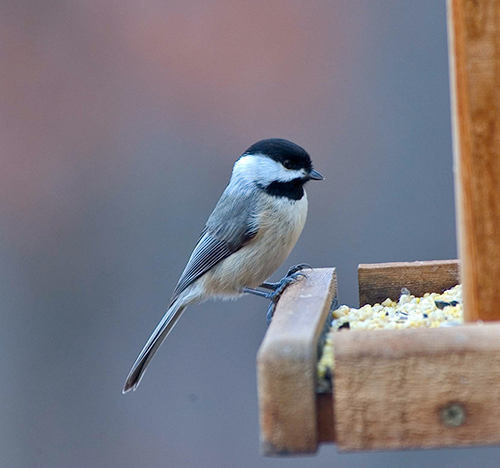
Scientific name: Poecile carolinensis
Length: 4.75 inches
Weight: .37 ounces
Wingspan: 7.5 inches
Song: “see-dee, see-dew”
The Carolina Chickadee is a small, cute, grayish and buff bird with a black cap, black throat, and white face. Males and females look the same and have stubby black beaks, strong, blue-gray legs and feet, and some pale edging on the feathers in their wings and tails.
This small bird mostly feeds on insects and seeds. It finds food by foraging with flocks of other small birds and picking small bugs and other items from bark, foliage, and twigs. Carolina Chickadees often hang upside down from twigs while foraging and are regular visitors to bird feeders.
These fun little birds nest in tree cavities and nest boxes, and live in parks, woodlands, and other habitats. As long as enough trees are present, they also commonly live in urban areas.
The Carolina Chickadee is a permanent resident from Maryland and Ohio west to Texas and south to northern Florida.
Key Identifications:
- The Carolina Chickadee is a small gray and buff bird with a smart black cap, black throat, and white face.
- Feeds on small insects and seeds. A regular visitor to bird feeders.
- Nests in tree cavities and nest boxes.
- Carolina Chickadees are vocal birds that make nasal “chick a dee dee dee” calls, and a high-pitched, “see-dee, see-dew”.
The Carolina Chickadee is a small grayish bird with a black cap and throat. They usually occur in small flocks that forage for insects and seeds as they chatter and move through woodlands and park-like habitats. This species uses its excellent memory to recall where it keeps hidden bits of food.
Mourning Dove
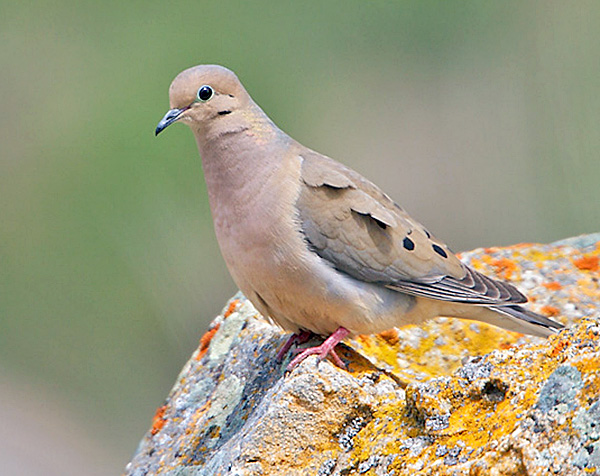
Photograph © Greg Lavaty.
Scientific name: Zenaida macroura
Length: 12 inches
Weight: 4.2 ounces
Wingspan: 18 inches
Song: “hooOOA, hoo, hoo, hoo”
Mourning Doves are medium-sized, grayish-brown doves with long tails. They have small black spots on their wings and a small head with a slender, dark beak.
Males and females also have narrow gray eyerings, a black mark on the face, and pale iridescent gold on the sides of their necks. They look alike except for males having more gray on the head and neck, and more iridescence.
This dove has fairly long wings and swift, direct flight. When flying, it shows black and white in its tail.
The Mourning Dove occurs in woodlands, gardens, on farms, and in urban areas. This common feeder visitor eats seeds and grains. It also forages in open situations, picking food from the ground.
This pleasant dove species can visit a feeder on its own or forage in small flocks. It builds an unkempt stick nest in bushes and trees and is very common throughout the USA, southern Canada, and Mexico.
Key Identifications:
- Plain brown and gray dove with a long, pointed tail.
- Feeds on seeds at feeders and on the ground in open areas.
- Makes a small, messy nest of sticks in trees.
- Sings a sad and owl-like “hooOOA, hoo, hoo, hoo”.
The Mourning Dove is the common garden dove in most of its range. It often visits feeders and its cooing song is commonly mistake for an owl. This species has a short lifespan with many adults only living for a couple of years or less.
Tufted Titmouse
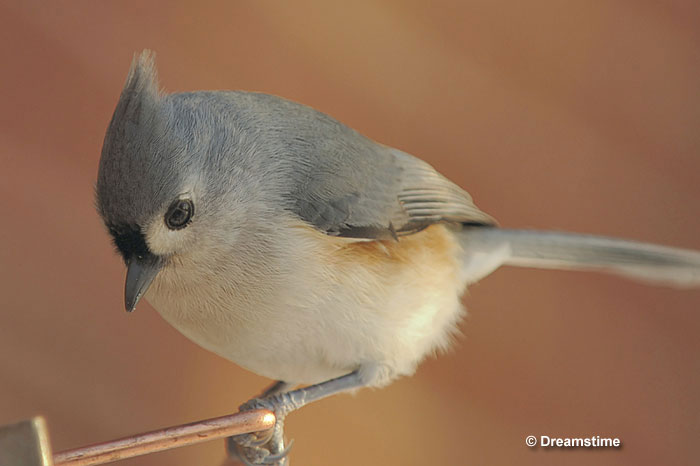
Scientific name: Baeolophus bicolor
Length: 6.5 inches
Weight: .75 ounces
Wingspan: 9.75 inches
Song: “peter peter peter”
The Tufted Titmouse is a small, crested, blue-gray bird with a white face. Males and females look the same and have a small black mark above their stubby black beak. They also have pale underparts with peach-orange flanks.
These cute little birds occur in small groups that forage for insects and seeds in parks and woodlands. They move through the trees and use their bills to pick food from leaves, bark, and branches. Tufted Titmouse are also regular visitors to bird feeders.
These small birds nest in woodpecker holes and other cavities in dead trees, and can also use nest boxes.
We find the Tufted Titmouse in hardwood forests and forested urban areas. They are often heard before they are seen, and flock with other small birds. When they see a predator, they are some of the first birds to harass it.
The Tufted Titmouse occurs in the eastern USA and some parts of southeastern Canada.
Key Identifications:
- Small, crested blue-gray bird with pale underparts and a white face.
- Feeds on seeds and insects and visits feeders.
- Nests in tree cavities and nest boxes.
- The Tufted Titmouse is a very vocal bird. It gives constant whistled calls over and over, “peter peter peter“.
The Tufted Titmouse is an easily recognized bird that lives in parks, gardens, and woodlands. It occurs in small flocks, often visits feeders, and needs dead trees or nest boxes to breed. This species lines its nest with mammal hair including fur from Raccoons, Opossums, and other animals.
Eastern Bluebird
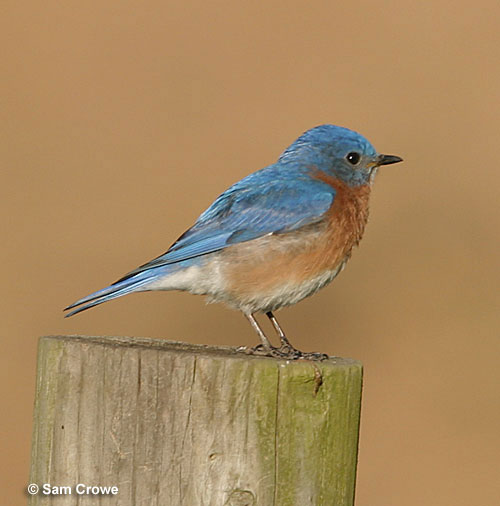
Scientific name: Sialia sialis
Length: 6.3 to 8.3 inches
Weight: 1.0 to 1.1 ounces
Wingspan: 9.8 to 12.6 inches
Song: “tu-a-wee”
Male Eastern Bluebirds are brick-red or rusty on their breast and throat and are a deep, vivid blue above. How blue these birds look fully depends on the lighting at the time. From a distance, males often look like a dull gray-brown. Female Eastern Bluebirds are a subdued orange-brown on the breast, grayish above, and have bluish wings and tails.
Eastern Bluebirds inhabit open country around trees. However, these locations have sparse ground cover and little understory. These birds primarily consume insects on the ground; some of the prey they consume include beetles, caterpillars, crickets, spiders, and grasshoppers.
Key Identifications:
- These birds are deep blue above and brick-red or rusty on their breast and throat.
- When Bluebirds are perched, the tips of their wings reach the base of their tail.
- Eastern Bluebirds are the size of a large sparrow but have a more upright posture.
- They have short necks, rounded heads, and short, thin bills.
Eastern Bluebirds are common birds that can be found in all parts of North America. They’re usually year-round residents of the southern portions of the country. They’re commonly seen in nesting boxes and old woodpecker holes, up to 50 feet off the ground. You can attract these birds to your yard by offering a smaller birdhouse because they prefer to nest in snug, tight spaces.
Downy Woodpecker
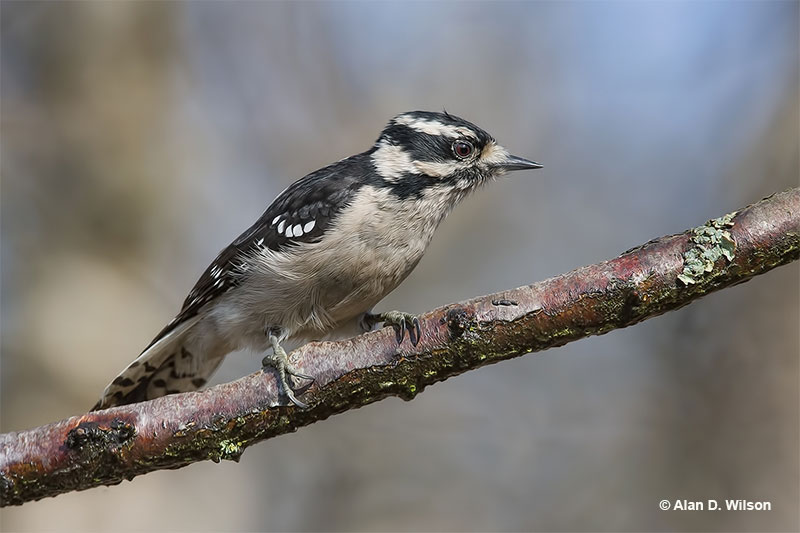
© Alan D. Wilson
Scientific name: Dryobates pubescens
Length: 6.75 inches
Weight: .95 ounces
Wingspan: 12 inches
Song: “Pik! Ch,ch,ch,ch,ch,ch,ch!”
The Downy Woodpecker is a small black and white woodpecker with a short, black beak. They are patterned black and white above and have white backs and white underparts. Both sexes look alike except that males have a small, bright red patch on the top back part of their head.
Young birds look like adults but have a reddish patch on the top of their head. Downy Woodpeckers also have a few small black marks in their white outer tail feathers, and a small white tuft at the base of their beak.
This woodpecker eats insects, other small creatures, seeds, and small fruits. It pecks into live and dead wood and often forages on smaller branches and twigs. These friendly little woodpeckers are also common feeder birds.
They nest in tree cavities and live in gardens and a wide variety of woodlands. We see Downy Woodpeckers in much of Canada and the USA but not in arid habitats.
Key Identifications:
- Smallest woodpecker in North America. Mostly black and white with a short, black beak.
- Forages on trees, in bushes, and at feeders for insects, seeds, and suet.
- Nests in tree cavities.
- The Downy Woodpecker makes sharp “pik!” calls and also has a trilled call, “Ch,ch,ch,ch,ch,ch,ch!“.
Downy Woodpeckers are the smallest woodpecker species in North America and usually occur in pairs. They can also forage with other small birds and often visit feeders. This species takes advantage of its size to peck into the stems of weeds and other plants too small for larger woodpeckers to perch on.
Great Blue Heron
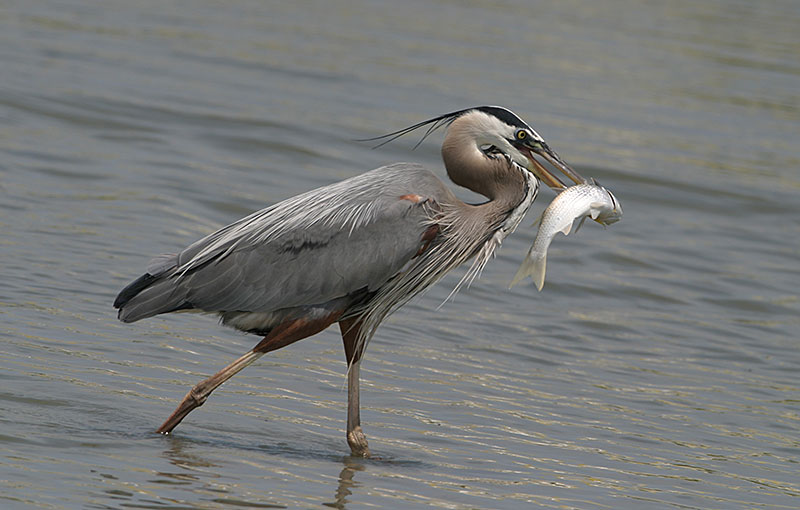
Great Blue Heron
Scientific name: Ardea herodias
Length: 46 inches
Weight: 5.3 pounds
Wingspan: 72 inches
Song: “Grunk! Grunk!”
The Great Blue Heron is a large, gray and pale brown heron with a long neck and legs. It has a strong, yellowish beak, black and white head with a wispy black crest, and rufous thighs.
Both sexes are alike and have pale bellies and black flanks. Juveniles have streaked underparts.
In flight, they make slow, deep flaps with long, broad gray and black wings. In Southern Florida and the Caribbean, Great Blue Herons are all white and sometimes considered a separate species, the “Great White Heron”.
These powerful herons feed on fish and small animals such as rats, snakes, and birds. They wade in and near water, wait, and then quickly catch prey with their sharp beaks.
Great Blue Herons build messy, stick nests and breed in colonies, often in swamps.
We find these impressive birds in and near a wide variety of wetlands in large parts of Canada, the USA, and the Caribbean.
Key Identifications:
- Huge gray and pale brown wading bird with a thick, yellowish beak and a wispy crest. In southern Florida, it is all white but still has a crest and a strong yellowish beak.
- Stalks and preys on fish and small animals.
- Builds messy stick nests and breeds in colonies.
- Great Blue Herons aren’t all that vocal. When taking flight they make a croaking sound, “Grunk! Grunk!“.
The Great Blue Heron occurs on rivers, lakes, and many other wetlands. It stands still for long periods of time while waiting for prey to come within range of its sharp beak but is also, often seen in flight. In some parts of Florida, Great Blue Herons have a gray and brown body and a white neck and head. These birds are known as, “Wurdemann’s Heron”.
Red-winged Blackbird
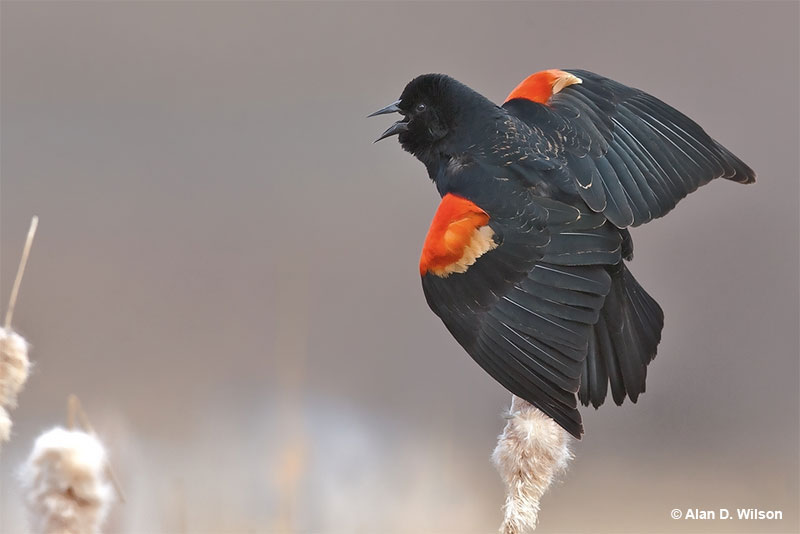
Scientific name: Agelaius phoeniceus
Length: 8.75 inches
Weight: 1.8 ounces
Wingspan: 13 inches
Song: “kan-keree!”
The Red-winged Blackbird is a medium-sized blackbird species with a sharp, all black bill. Males also have a scarlet patch with a pale yellow border on the shoulder of each wing.
Female Red-winged Blackbirds are dark, heavily streaked, brownish-gray birds with an orange-buff eyebrow and throat. She can also have a little bit of dingy red on her shoulder.
Red-winged Blackbirds often flock together and can form very large groups in the winter. They feed on seeds, grain, and insects found on lawns, in marshes, farm fields, and other open habitats.
This species builds a cup nest made of leaves and dead stems in a bush or other low vegetation in a marsh, park, or brushy field.
Red-winged Blackbirds are very common birds that live in all sorts of open habitats. We see them in parks, farming areas, and marshes in much of Canada, the USA, Mexico, and parts of the Central America.
Key Identifications:
- Males are medium-sized blackbirds with a bright red patch on their wings. Females are heavily streaked, have a sharp black beak, and buff on the head.
- Feeds on seeds, grain, and insects on the ground in many open habitats.
- Builds a cup nest in a bush or other low vegetation.
- Red-winged Blackbirds often call. Males sing a loud, “kan-keree!” and both sexes also make “check!” calls and a high-pitched whistle-like sound.
The Red-winged Blackbird is a common, social species easily seen in marshes and open habitats. In the winter, it can form huge flocks that feed in farm fields. This species can make a daily commute of 50 miles to and from roosting and feeding sites.
American Crow
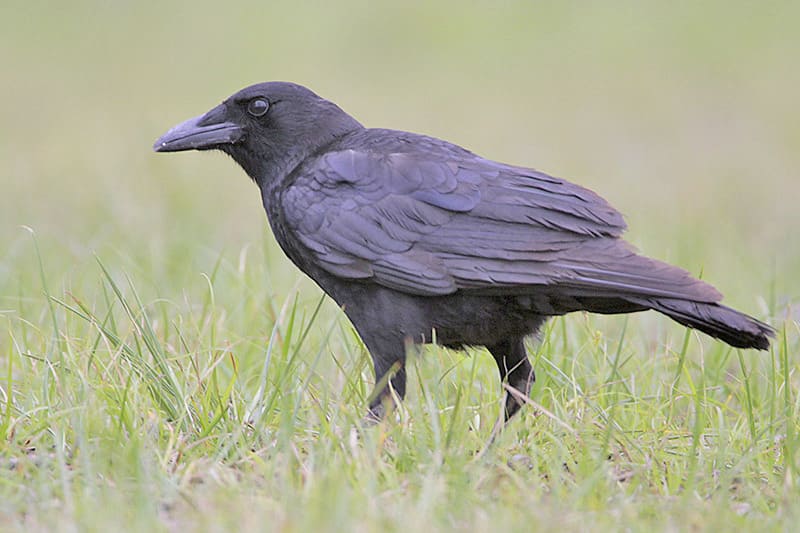
Photograph © Greg Lavaty
Scientific name: Corvus brachyrhynchos
Length: 17.5 inches
Weight: 1 pound
Wingspan: 39 inches
Song: “Caw, Caw, Caw!”
The American Crow is a large, black bird with a stout, slightly hooked beak. In some lighting, this species is also highlighted with metallic blue and purple iridescence.
Male and female American Crows resemble each other, have feathers on part of their bills, long, broad wings, and a broad tail.
This big bird can fly for several miles with steady wing beats. These social and complex birds typically occur in flocks, and are very intelligent.
American Crows usually feed on the ground and are omnivores that will eat almost anything they find.
This varied diet can include everything from dead animals to nuts, fruit, carrion, insects, and small animals. As with other members of the Corvid family, crows won’t hesitate to feed on the eggs and nestlings of other birds.
It makes bulky stick nests in trees and occurs everywhere except in deserts and high elevations.
American Crows range from Alaska to Canada and south to Texas.
Key Identifications:
- Large, hefty, black bird with long, broad wing and a broad tail.
- An omnivore that feeds on carrion, seeds, insects, fruit, and small animals.
- Makes bulky stick nests.
- The American Crow is a loud and noisy bird. They are capable of making all sorts of sounds but their most frequent call is, “Caw! Caw! Caw!”.
American Crows are big, black birds with long, broad wings. They are social and easily seen in towns, on farms, and many other habitats. This species is very smart and can even be taught to mimic human speech.
House Finch
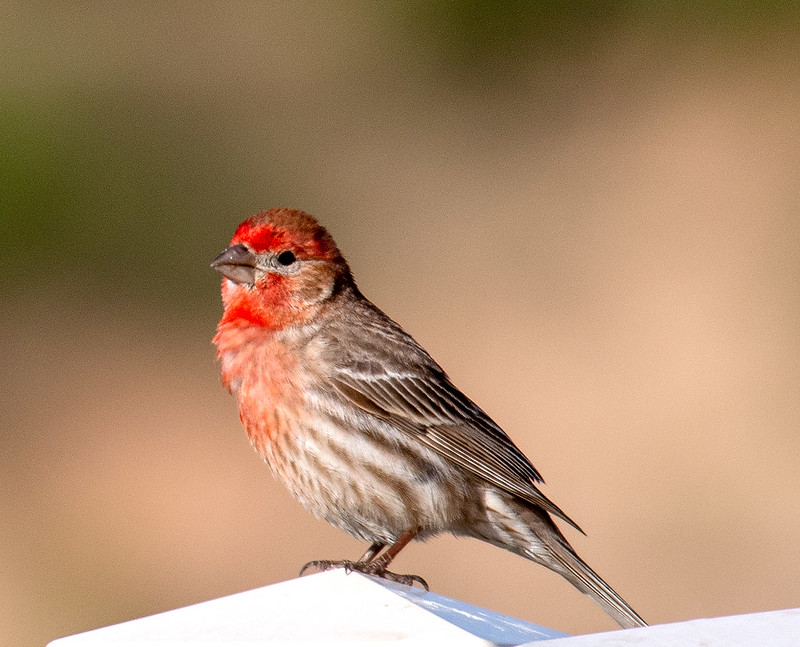
© John Hansen
Scientific name: Haemorhous mexicanus
Length: 6 inches
Weight: .88 ounces
Wingspan: 10 inches
Song: “chip,chip,chiprididip,ZREEYachip”
House Finches are sparrow-sized birds with dark, rounded beaks and fairly long wings. Males are orange-red or rose-red on their head, throat and breast, and have some red on their rump. They also have brownish streaks on their back, flanks, and white belly.
Like the male, female House Finches have two white wing bars on long, gray-brown wings. However, they lack red and are mostly streaked, dull brown-gray birds.
House Finches feed on seeds, buds, fruit, and flowers. They often visit feeders in Mississippi but also forage on the ground, and in bushes and trees.
We see these pretty birds in deserts and arid zones, and in parks, farmland, urban areas, and other semi-open habitats.
The House Finch makes a soft cup nest built on a tree, building ledge or other spot with some overhanging cover. They often occur in small groups and live in southern Canada, most of the USA, Mexico, and Hawaii.
Key Identifications:
- Reddish or plain gray-brown, streaked, sparrow-like bird.
- Eats seeds, flowers, buds, and fruit. Can visit feeders but also forages on the ground and in bushes and trees.
- Makes a soft cup nest in trees, on building ledges, and other places.
- The House Finch often makes a soft, “fidip” call. Males also sing a warbling song from prominent, high perches. It sounds like, “chip,chip,chiprididip,ZREEYachip”.
House Finches are sparrow-like, reddish or brownish, streaked birds. They live in arid zones as well as in parks and urban areas. All of the millions of House Finches that live east of the Rocky Mountains are descendants of birds released on Long Island in 1939.
Yellow-rumped Warbler
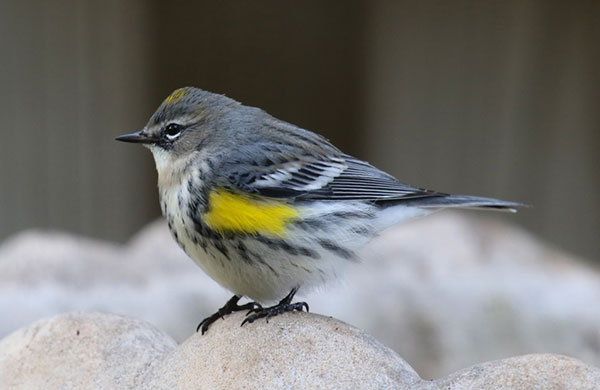
Scientific name: Setophaga coronata
Length: 5.5 inches
Weight: .42 ounces
Wingspan: 9.25 inches
Song: “si,sit,sit,sit,sit,sue,sue,sue”
The Yellow-rumped Warbler is a small, blue-gray songbird with a yellow rump, crown, and yellow patches on each side of its breast. It also has two white wing bars, dark marks on the back, and white underparts with blackish markings on its breast and sides.
In summer, this species has a blackish face and white markings above and below the eyes. Females are like males but duller. In winter, both sexes of Yellow-rumped Warblers are duller and have more brownish plumage.
The western subspecies has a yellow throat and more white in the wings.
This species feeds on insects and small berries. It picks food from vegetation and briefly flies into the air to catch bugs in flight.
Yellow-rumped Warbler build small cup nests in conifers in Canada and the northeastern and western USA. They spend the winter in semi-open habitats from the southern USA to Central America.
Key Identifications:
- Small songbird with two pale wing bars and yellow patches on the rump, each side of its breast, and crown.
- Feeds on insects and small berries.
- Builds cup nests in conifers in northern and montane forests.
- The Yellow-rumped Warbler makes a sharp call note, “chup!”, and sings a brief and easy-going warbling song, “si,sit,sit,sit,sit,sue,sue,sue”.
Yellow-rumped Warblers are small, blue-gray or brownish songbirds with two pale wing bars, and yellow patches on the crown, sides of the breast, and rump. In winter, they occur in small flocks that feed on insects and berries in parks and other semi-open habitats. The eastern subspecies is known as the “Myrtle Warbler” and the yellow-throated western subspecies is called, “Audubon’s Warbler”.
Great Egret
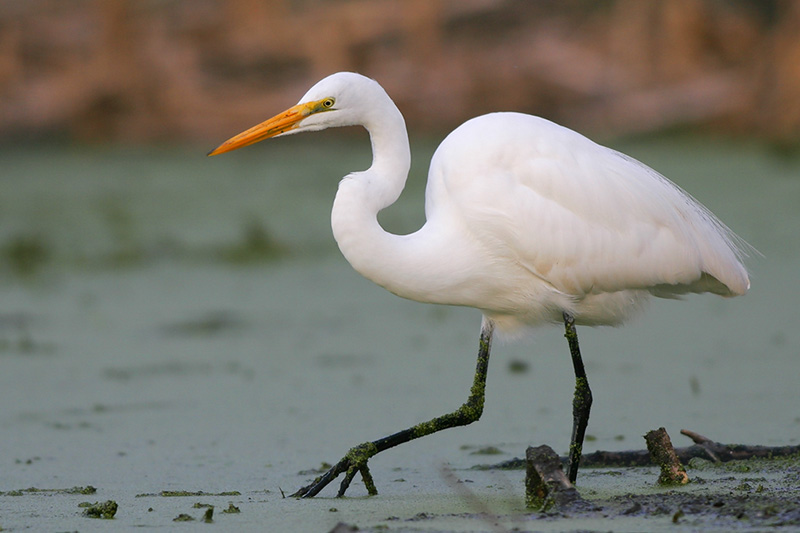
Photograph © Greg Lavaty.
Scientific name: Ardea alba
Length: 39 inches
Weight: 1.9 pounds
Wingspan: 51 inches
Song: “koorr”
The Great Egret is a big, white heron with a long neck, and long dark legs and feet. Both sexes look similar and have long, sharp yellow beaks, and pale eyes.
In breeding season, they have long, elegant white plumes on their backs, and greenish skin in front of their eyes.
In flight, this large waterbird shows long, broad wings and a short, broad tail. Its legs trail out behind it and the bird holds its neck tucked in.
Great Egrets feed on fish, frogs, snakes, and other small animals that venture too close, birds and rodents included. They wade in or near water and then wait until prey comes close. If the animal approaches within range, they quickly catch it with their long, sharp beak.
The Great Egret nests in colonies and builds a big, messy, stick nest. It is common in wetlands in much of the USA, parts of southern Canada, and many other parts of the world.
Key Identifications:
- Big white bird with a long neck, yellow beak, and dark legs and feet.
- Feeds in and near wetlands, on the ground. Catches fish and small animals with its long, sharp beak.
- Makes bulky stick nests in colonies.
- Great Egrets make deep, croaking sounds, especially when taking flight. “koorr…koorr“
The Great Egret is a common and conspicuous bird of wetland habitats. It can be seen alone or in groups taking advantage of an easy food source. They use their long, sharp bills to catch a wide variety of animals. This species is also the symbol of the Audubon Society. This organization was formed in 1905 to protect Great Egrets and other birds. At that time, in the USA, these large herons had been hunted to near extinction to supply elegant plumes for women’s hats.
Eastern Towhee
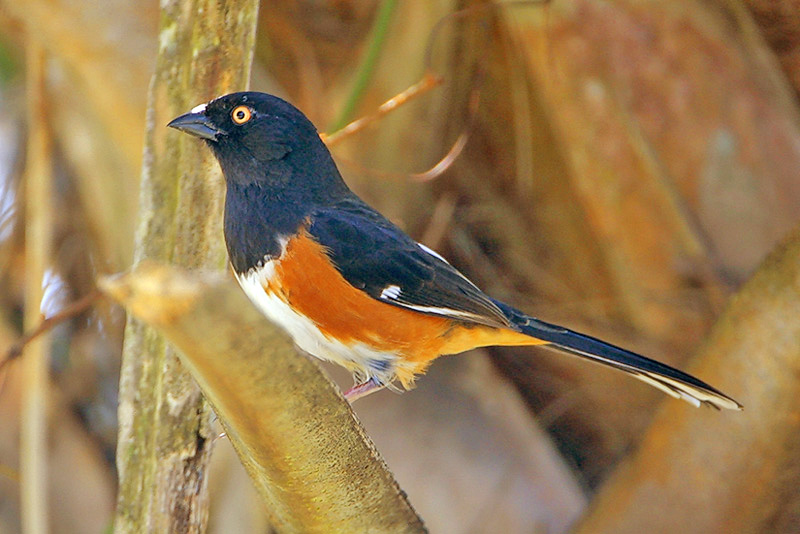
Photograph © Greg Lavaty.
Scientific name: Pipilo erythrophthalmus
Length: 6.8 to 8.2 inches
Weight: 1.1 to 1.8 ounces
Wingspan: 7.9 to 11.0 inches
Song: “drink-your-tea”
Male Eastern Towhees are prominent with their bold sooty black on the breast and above. Additionally, they have white on the belly and warm rufous sides. Female Eastern Towhees have the same pattern but are dark brown, where the birds are black.
Eastern Towhees are common residents of forest edges, thickets, overgrown fields, scrubby backyards, and woodlands. The most important qualities of their habitat seem to be plenty of leaf litter and dense shrub cover. Eastern Towhees can be seen in the Appalachians to about 6,500 feet.
Towhees in Mississippi consume a wide variety of foods, including insects, seeds, snails, fruits, spiders, centipedes, etc.
Key Identifications:
- These birds are a sooty black above and on the breast as well as warm orange on the sides and belly.
- Eastern Towhees are around the same size as the American Robin.
- They have thick, triangular bills, chunky bodies, and long, rounded tails.
- Eastern Towhees have oval-shaped eggs that are grayish, pale, or creamy white and can be dotted with gray, red-brown, or brown markings.
Eastern Towhees are abundant in the eastern portions of the United States. Listen carefully for their scratchy call when in their habitat. These birds won’t directly visit bird feeders, but they may feed directly below the feeders, picking up fallen seeds off the ground. They like cracked corn, millet, oats, and milo.
Brown Thrasher
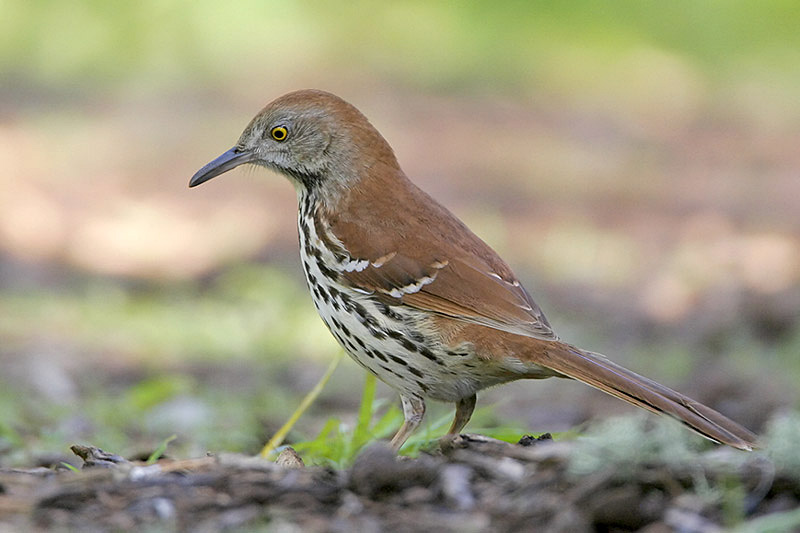
Photograph © Greg Lavaty.
Scientific name: Toxostoma rufum
Length: 9.1 to 11.8 inches
Weight: 2.1 to 3.1 ounces
Wingspan: 11.4 to 12.6 inches
Song: “plant a seed, plant a seed, bury it, bury it, cover it up, cover it up, let it grow, let it grow, pull it up, pull it up, eat it, eat it.”
Brown Thrashers are reddish-brown birds with thick, dark streaking on their white underparts. Their eyes are bright yellow, their faces are gray-brown, and their wings have black-and-white wing bars.
Brown Thrashers nest in hedgerows, thickets, and forest edges in the eastern portions of North America (being one of the most common birds in Mississippi. Farther west, Brown Thrashers breed in woody draws, shelterbelts, and fencerows.
These birds mainly consume insects and other arthropods along with seeds, nuts, and fruits. They usually feed on the ground, sweeping their bills through the soil and leaf litter with fast, sideways motions.
Key Identifications:
- Brown Thrashers are reddish-brown birds with thick, dark streaking on their white underparts.
- Male and female Brown Thrashers look identical.
- Brown Thrashers are a little bit smaller than Blue Jays.
- Brown Thrashers are slender, relatively large songbirds. They have long legs, slightly downcurved, long bills, and long tails that are often cocked upward.
Brown Thrashers can be hard to spot because they like to stay hidden in tangled masses of shrubbery. Their expression looks stern due to their slightly downcurved, heavy bill and striking yellow eyes. Brown Thrashers may visit your backyards if you offer the right food and there’s dense cover close by.
American Robin
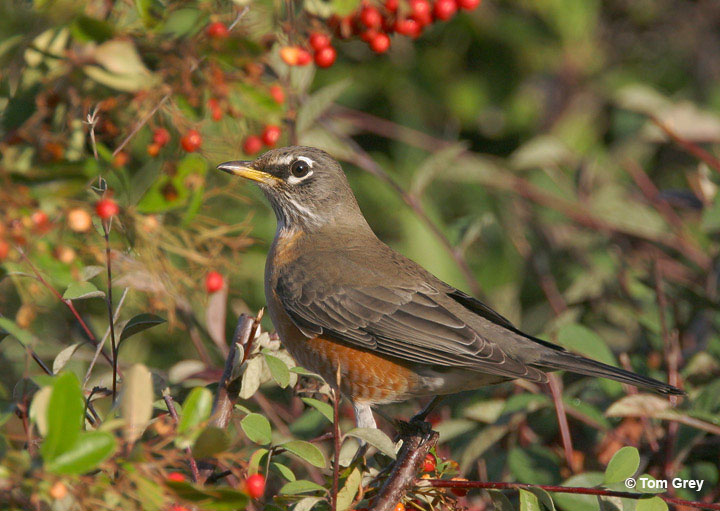
© Tom Grey
Scientific name: Turdus migratorius
Length: 10 inches
Weight: 2.7 ounces
Wingspan: 17 inches
Song: “cheery, cheery, cheery, cheery, cheer, cheer”
The American Robin is a familiar and common thrush that is dark gray above and brick red below. It also has an orange-yellow bill, a blackish head with white markings around the eyes and on the throat, and a white belly.
Both sexes of this thrush species are similar but males are darker above and more reddish on the underparts. Young American Robins have more white marks on their faces and spotting on orange underparts.
In flight, this common thrush in Mississippi also shows white corners in its outer tail feathers.
American Robins forage on the ground for worms, insects, snails, and other small creatures. In winter, these common birds flock together and perch in trees and bushes to eat berries and fruit.
The American Robin makes a cup nest in trees and lives in parks, woodlands, towns, and many other habitats. They reside in Alaska, most of Canada, the USA and in Mexico.
Key Identifications:
- Fair-sized songbird that is dark gray above, and brick red and white below.
- Forages for worms and bugs on lawns and other open grassy areas, also flocks together to feed on fruiting trees in the winter.
- Makes a cup nest in trees.
- The American Robin is quite vocal and makes a loud, sharp, “yenk!” call and quieter “check,check,check” calls. It also has a lovely cheerful song of caroled phrases, “cheery, cheery, cheery, cheery, cheer, cheer”.
The American Robin is a common, handsome thrush with dark gray upperparts and brick red and white underparts. It forages for worms and bugs on lawns and other open, grassy spots, and also eats berries. Populations of the American Robin have been estimated at 370,000,000; a number that gives this bird the distinction of being the most numerous landbird in North America.
European Starling
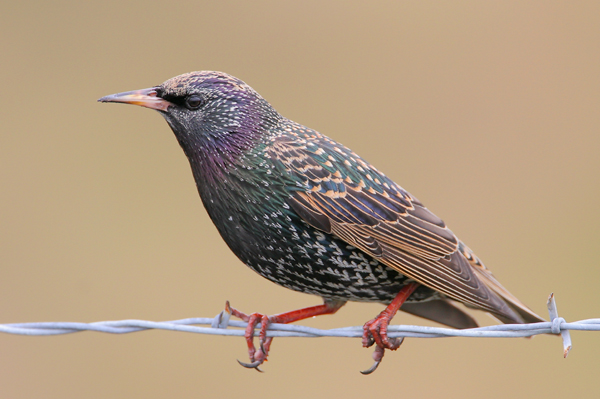
Photograph © Greg Lavaty.
Scientific name: Sturnus vulgaris
Length: 8.5 inches
Weight: 2.9 ounces
Wingspan: 16 inches
Song: “tiktiktitZHREEree..tiktiktik..ZHREE”
European Starlings are plump, short-tailed birds with long sharp beaks and longish, pointed wings. In summer, they have yellow beaks, glossy black plumage with purple and green highlights, and some small white spots.
Males and females are similar but males have less spotting and glossier plumage. In winter, they have black beaks, white spots, and more reddish colors in their wings.
Young starlings are shaped like adults but are grayish birds with a dark beak and a pale throat.
This species feeds on a variety of insects, fruit, and seeds. They can dominate bird feeders and are common species in urban areas, parks, farmlands, and other open habitats.
This European Starling builds a soft cup nest in a tree cavity, nest box, or suitable cavity in other structures.
European Starlings flock with each other and blackbird species, especially during the winter. They live across a large part of Canada and the USA.
Key Identifications:
- Rotund, short-tailed bird with a long, sharp beak, and pointed wings. Glossy black with some spotting in the summer and blackish with heavy white spotting and streaking in the winter.
- Feeds on seeds, fruit, and insects. Visits feeders and forages on the ground in flocks.
- Builds a soft cup nest in nest boxes and other cavities.
- The European Starling makes a wide variety of mechanical and whistled sounds. They also mimic other birds and sounds in their environment. They sing long, jumbled mechanical-sounding songs, “tiktiktitZHREEree..tiktiktik..ZHREE”.
European Starlings are rounded, blackish birds with long, sharp beaks and short tails. They live in towns, cities, parks, on farms, and in other open habitats. This species forms large flocks called, “murmurations” that move in coordinated patterns.
Turkey Vulture
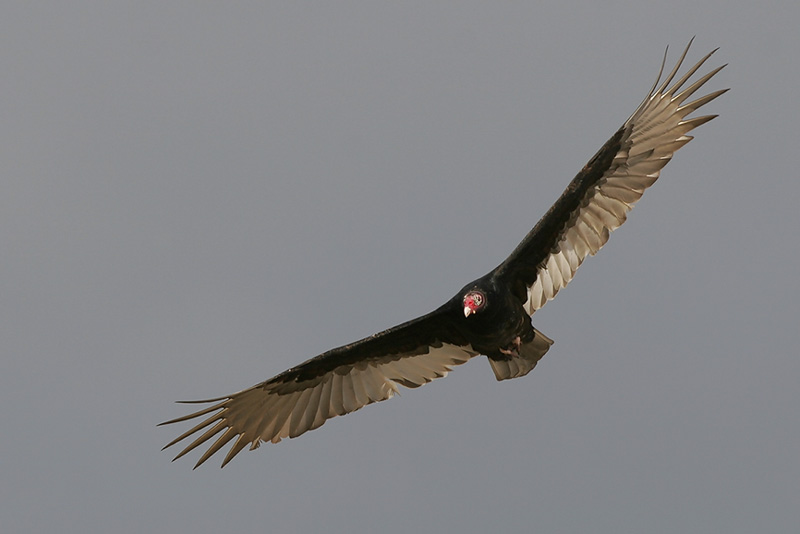
Scientific name: Cathartes aura
Length: 26 inches
Weight: 4 pounds
Wingspan: 67 inches
Song: “hisss”
The Turkey Vulture is a big, dark brownish-black raptor with a small red head and long, broad wings. Males and females look alike and also have a longish tail.
In flight, the way Turkey Vultures soar is one of the best ways to recognize them. They fly with their wings held in a “V” shape and, when gliding, often rock back and forth.
Their flight feathers are also paler than the rest of their wings but they lack the Black Vulture’s white wing patch.
Turkey Vultures are scavengers and most of their diet is carrion. They eat road kill and a wide variety of dead animals. This species forages over every type of habitat and can also fly over urban areas.
It lays two eggs on the ground in caves and hollow logs.
The Turkey Vulture lives in southern Canada and in most of the USA south to southern Argentina.
Key Identifications:
- Big, dark raptor with a small red head that soars with long wings held in a “V”.
- Feeds on dead animals.
- Nests on the ground in caves and hollow logs in secluded areas.
- Turkey Vultures rarely call and mostly make hissing sounds at their nest.
The Turkey Vulture is commonly seen flying over every type of habitat. They are often seen on their own but can occur in flocks, especially during migration. Unlike most other birds, this species uses its amazing sense of smell to find dead animals.
Laughing Gull
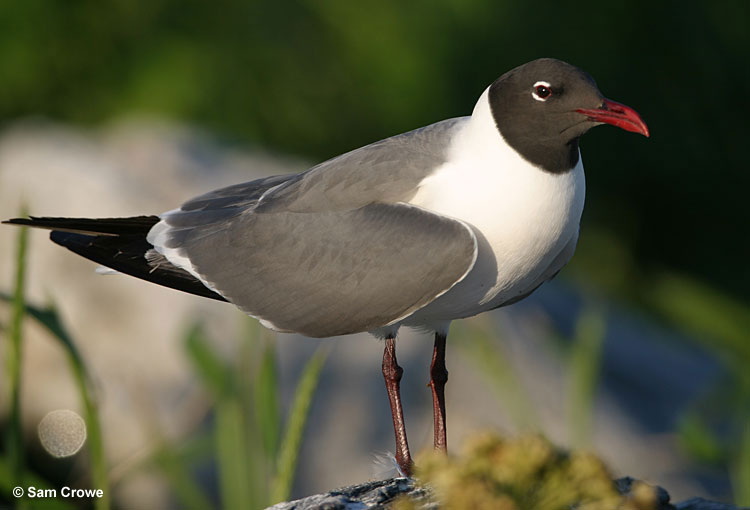
Scientific name: Leucophaeus atricilla
Length: 16.5 inches
Weight: 11 ounces
Wingspan: 40 inches
Song: “rih, ih, ih, ih, ih, ih, rah ha”
The Laughing Gull is a medium-sized gull with a dark gray back, mostly black wingtips, and two white marks above and below the eyes. In breeding plumage, male and female Laughing Gulls have thick, slightly hooked reddish beaks, and black heads.
In winter, they have a dark bill with a reddish tip and only a bit of black on the head. Young birds are like winter adults but have more marks on their heads and darker wings.
Laughing Gulls feed on fish, carrion, berries, small creatures, and other items that they find on beaches and other coastal habitats. These social birds usually occur in flocks and pick up food with their beaks.
They breed in colonies and make bulky, shallow cup nests out of sticks and other vegetation on coastal islands.
The Laughing Gull lives in coastal habitats of the eastern USA, Gulf of Mexico, and the Caribbean south to northern South America.
Key Identifications:
- Medium-sized gull with a dark gray back and wings, two white marks above and below the eyes, and, a black head (summer), or a white head with dark marks (winter).
- Feeds on fish, berries, and many other food items it finds in salt marshes and on beaches.
- Breeds in colonies on coastal islands and makes a bulky, shallow cup nest of sticks on the ground.
- The Laughing Gull is a vocal bird that makes brief laughing sounds, “rih, ih, ih, ih, ih, ih, rah ha”.
Laughing Gulls are medium-sized gulls with dark gray back and wings and black heads (in the summer). They mostly occur in coastal habitats where they feed on everything from fish to carrion, nestlings, and berries. In the late 19th century, egg collectors and bird hunters nearly eliminated this common species from parts of the eastern USA.
Fish Crow
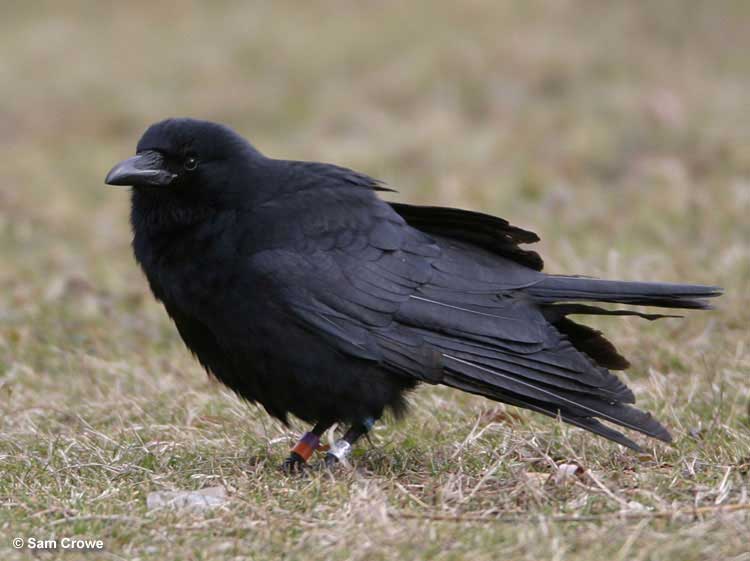
Scientific name: Corvus ossifragus
Length: 15 inches
Weight: 10 ounces
Wingspan: 36 inches
Song: “cuh”
The Fish Crow is a large, all black bird with a stout, black beak. Both males and females look the same and have some feathers on top of their bill, long wings, and a broad tail. In certain lighting, they also show some dark blue and purple highlights.
This species feeds on small creatures and a wide variety of food items found in coastal habitats and in other wetlands. It also scavenges for carrion and preys on eggs and nestlings of other bird species.
In particular, Fish Crows are important predators at nesting colonies of waterbirds.
After breeding, Fish Crows form large flocks and, in many places, they have become adapted to living in urban areas. These birds have become used to people but don’t usually visit feeders.
They build large, messy stick nests high in trees, and only live in coastal areas and wetlands in the eastern USA.
Key Identifications:
- Large black bird with long wings and a broad tail.
- Feeds on carrion, small animals, and many other food items.
- Makes messy stick nests in trees.
- Fish Crows are vocal, social birds. Their nasal call is the best way to separate them from the American Crow. It sounds like, “cuh, cuh“.
The Fish Crow is a common and conspicuous bird in coastal areas and near rivers and lakes. This omnivorous bird feeds on a variety of items and can form large flocks in fall and winter. Although Fish Crows were historically restricted to shorelines and coastal marshes, they have become adapted to living with people and are expanding their range.
White-eyed Vireo
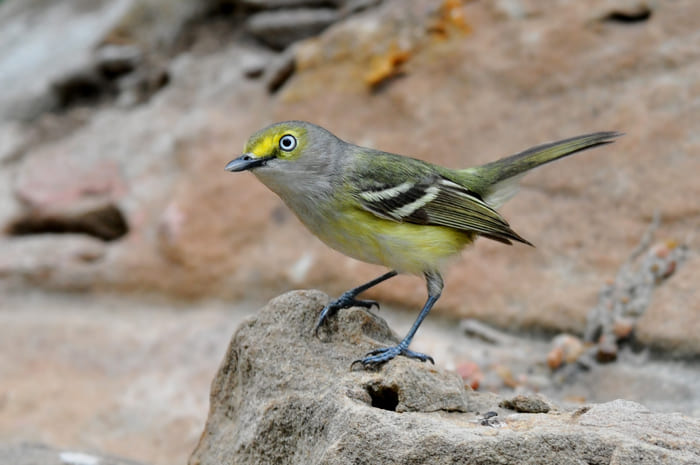
Scientific name: Vireo griseus
Length: 5 inches
Weight: .4 ounces
Wingspan: 7.5 inches
Song: “chick, perk-or-REEoCHICK!”
The White-eyed Vireo is a small, olive and gray bird with yellow spectacles and flanks. Males and females look alike, have a small dark mark in front of their white eyes, and two white wing bars.
Young birds resemble adults but have more gray on the head and can have white spectacles and dark eyes. Like adults and other vireo species, they also have thick, gray beaks with small hooked tips.
This common bird in Mississippi feeds on caterpillars and other insects. It finds food by carefully moving through dense vegetation and picking items from foliage and twigs.
The White-eyed Vireo does not usually flock with other birds and uses spider webs and plant matter to build a cup nest that hangs below thin branches.
White-eyed Vireos breed in scrubby second growth in the eastern USA north to Ohio, and winter in similar habitats from the southeastern USA to northern Central America.
Key Identifications:
- Small olive and gray bird with yellow spectacles, white eyes, and pale underparts with yellow flanks.
- Forages for insects in scrubby second growth.
- Makes a cup nest of spider webs, lichen, and plant matter built underneath thin branches.
- Often sings an excited, “chick, perk-or-REEoCHICK!”.
The White-eyed Vireo is a small, pale bird with white eyes and yellow spectacles. In summer, its song is often heard from scrubby second growth in much of the eastern USA. Both sexes of the White-eyed Vireo sing on wintering grounds, but only males sing on their breeding grounds.
Double-crested Cormorant
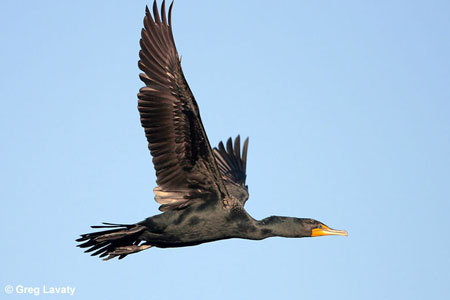
Scientific name: Nannopterum auritum
Length: 33 inches
Weight: 3.7 pounds
Wingspan: 52 inches
Song: “groak”
The Double-crested Cormorant is a big, glossy black bird with a long, thick neck. Males and females look alike and also have a medium-length beak with a sharp, hooked tip, an orange throat patch, and a bit of orange on the face.
Double-crested Cormorants have a short, wispy crest, green eyes, broad tail, and big webbed feet. They use their long wings to flap and glide with direct flight between feeding and roosting areas.
This highly aquatic species feeds on fish. It catches its food by diving, swimming beneath the water and then snatching a fish with its beak. It eats the fish while perched above the water.
The Double-crested Cormorant breeds in colonies and makes a messy stick nest in a tree on an island or above the water. We see this bird in parts of central and southern Canada, in much of the USA, and parts of Mexico and the Caribbean.
Key Identifications:
- Big, nearly goose-sized black bird with a long, thick neck, and a medium-length narrow beak with a small, hooked tip. It also has a rectangular, orange throat patch.
- Forages by floating and then diving beneath the water. Swims underwater to catch fish with its beak.
- Breeds in colonies and constructs a messy stick nest in trees on islands, or over water.
- Double-crested Cormorants aren’t very vocal. They make some low, guttural, pig-like sounds at their breeding colonies, “groak”.
The Double-crested Cormorant is a large, black bird with a long, thick neck and an orange throat patch. It often occurs in flocks that frequent lakes, rivers, and other wetlands. When it comes to fish, this species is not a picky eater; it has been documented eating more than 250 species.
Osprey
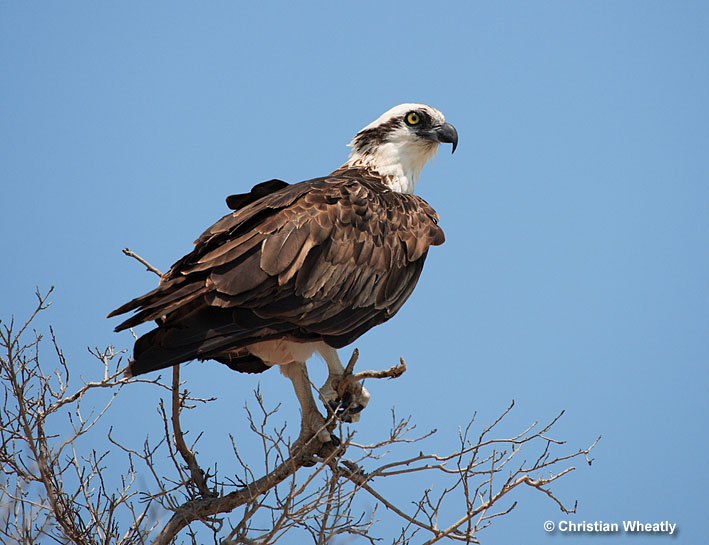
Scientific name: Pandion haliaetus
Length: 23 inches
Weight: 3.5 pounds
Wingspan: 63 inches
Song: “churp! churp! tewee tewee”
The Osprey is a large, pale raptor with long wings. It has a dark brown narrow mask, pale eyes, and a short crest.
Male and female Ospreys look alike and are dark brown above and white below with dark brown bands on their broad tail. They also have dark brown mottling on their underwings, and have a blue-gray, hooked beak.
Ospreys feed entirely on fish. They catch them by flying over water, and then soaring and hovering while looking down into the water. When they see a fish near the surface, they plunge down and snatch the fish with their long, sharp talons.
The Osprey then carries the fish to a tree to feed on it. This large bird builds big bulky, stick nests in trees and on platforms near waterways.
It lives along shorelines, in marshes, and on rivers and lakes in Canada, and many parts of the northern, western, and southeastern USA.
Key Identifications:
- Large pale raptor with long wings and a dark mask. It is dark above and white below.
- Feeds on fish caught in lakes, rivers, and along seashores.
- Makes bulky stick nests in trees and on platforms in wetlands.
- Ospreys are vocal birds and often call in flight. They make short, whistled calls that sound like, “churp! churp! tewee tewee”.
The Osprey is a common sight in coastal areas and around lakes, rivers, and other wetlands. They are often seen in flight as they hover above water to hunt for fish. During the 50s and 60s, the pesticide DDT caused large declines in Osprey numbers. Fortunately, since those years, they have recovered in most parts of their range.
White-throated Sparrow

Scientific name: Zonotrichia albicollis
Length: 6.75 inches
Weight: .91 ounces
Wingspan: 9 inches
Song: “Ohhh Canada Canada Canada”
The White-throated Sparrow is a chunky, gray and brown sparrow with a white throat, and black and white stripes on its head. It has dark streaks on its back, a gray rump, and a bit of yellow in front of its eyes.
Males and females look the same and have reddish-brown wings with two white wing bars. Young White-throated Sparrows and some adults are duller brown with tan stripes on their heads and a dingy white throat.
White-throated Sparrows forage for seeds and insects on the ground, and also eat fruits in short trees and bushes. They reveal hidden food items by using their feet to scratch and kick away leaves.
This sparrow breeds in northern forests and builds a cup nest with grass and twigs. They construct the nest at the edge of forest, on or close to the ground, in dense vegetation.
These sparrows usually occur in flocks and winter in the eastern and southwestern USA and parts of California.
Key Identifications:
- Large sparrow with a white throat and bold black and white or tan stripes on its head.
- Scratches leaves on the ground to find seeds and insects. They also eat berries.
- Makes a cup nest of grass, bark, and twigs, on the ground, under dense vegetation.
- Flocks of White-throated Sparrows often make sharp “tink” calls. They also sing a clear, whistled song, “Ohhh Canada Canada Canada” or, “Ohhh, Cana, Cana, Cana”.
White-throated Sparrows are hefty gray and brown sparrow species with white throats, and black and white or tan stripes on their head. They breed in northern forests and flock together during the winter in various woodland habitats. The yellow pigment in the patches in front of their eyes comes from eating colorful berries during fall and winter.
Pine Warbler
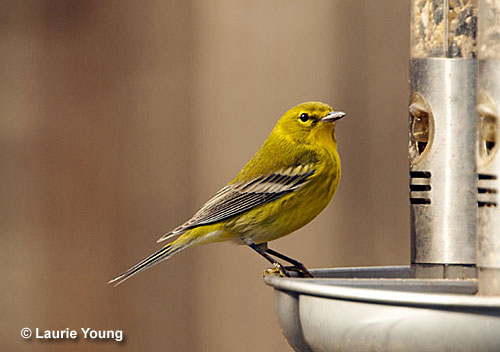
Scientific name: Setophaga pinus
Length: 5.1 to 5.5 inches
Weight: 0.3 to 0.5 ounces
Wingspan: 7.5 to 9.1 inches
Song: Quick trill of 10 to 30 notes
Pine Warblers have olive backs, gray wings with 2 white wing bars, whitish bellies, and are yellowish overall. Adult male Pine Warblers are bright, while immature females are duller and can look gray-brown in specific lighting. Overall, Pine Warblers don’t have the strong patterns that are commonly seen on other warbler species.
Pine Warblers inhabit mixed pine or pine deciduous forests. It’s important to note that you’ll rarely see them out of a pine tree. Migrating birds will sometimes use deciduous trees and shrubs.
Pine Warblers primarily eat caterpillars and other arthropods like beetles, ants, grasshoppers, bees, and flies. However, they also eat seeds and fruits, mostly during the winter months. They forage for food by hopping along branches in the middle on top of pine trees.
Key Identifications:
- Male and female Pine Warblers look similar, but females are duller than males.
- Pine Warblers have olive backs, gray wings with 2 white wing bars, whitish bellies, and are yellowish overall.
- Pine Warblers are smaller than White-throated Sparrows.
- Pine Warblers have stout bills and long tails. The tip of their tails usually has a central notch.
Pine Warblers are birds that are true to their name. They’re common in pine forests in the eastern portions of the United States. These birds love outdoor water running systems and birdbaths. They love the sound of dripping water! Additionally, you can attract them to your feeders with black oil sunflower seeds.
Canada Goose
Scientific name: Branta canadensis
Length: 29.9 to 43.3 inches
Weight: 105.8 to 317.5 ounces
Wingspan: 50 to 66.9 inches
Song: Canada Geese don’t have a song, but they do produce a variety of calls, including loud honks, hisses, cackles, and barks.
Canada Geese have white cheeks, black heads, white chinstraps, black necks, brown backs, and tan breasts.
Canada Geese live in many different habitats near grain fields, grassy fields, and water. These waterbirds are particularly drawn to lawns because when they’re caring for their young, manicured lawns give them an unobstructed, broad view of any approaching predators, and they can digest grass.
In the spring and summer months, geese concentrate on consuming sedges and grasses, including eelgrass and skunk cabbage leaves. During the fall and winter months, they rely more on seeds and berries, including berries and agricultural grains.
Key Identifications:
- Look for their white cheeks, white chinstraps, black heads, black necks, brown backs, and tan breasts.
- Male and Female Canadian Geese look identical. The best ways to differentiate the two is by looking at size and behavior.
- Canada Geese are larger than a Mallard.
- Canada Geese are large waterbirds. They have long necks, large bodies, wide, flat bills, and big webbed feet.
Thousands of Canada Geese migrate south and north every year. They’re easily recognizable with their long V-shaped formations. However, more and more of these birds are staying put in suburban and urban areas year-round, due to lawn maintenance.
Killdeer
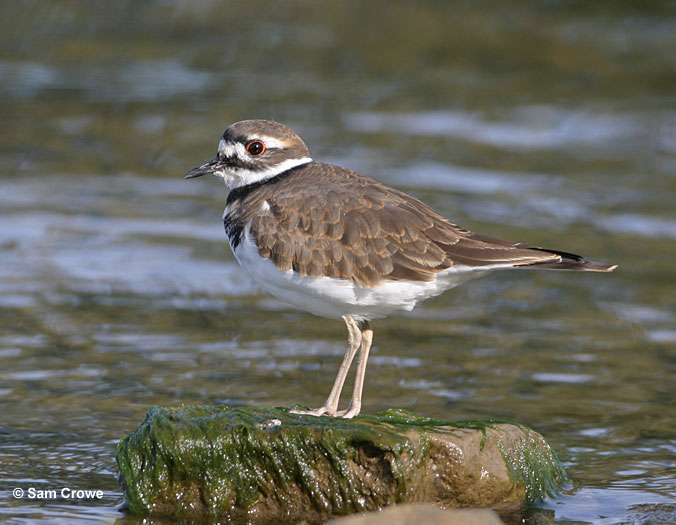
Scientific name: Charadrius vociferus
Length: 10.5 inches
Weight: 3.3 ounces
Wingspan: 24 inches
Song: “tideer, tideer, tideer, tideer”
The Killdeer is a fair-sized, slender plover that is dark brown above and white below. They have two black bands on their breast, a patterned, black, white, and dark brown face, and a longish, orange tail.
Both sexes look alike and also have a slender, black bill, narrow, red-orange eyerings, and long, pale legs. In flight, we can see a white stripe in each of their long, dark wings, and a black tip on their long, wedge-shaped, orange tail.
Killdeers often fly high overhead in fast, direct flight but we usually see them foraging on the ground. They pick insects, other small creatures, and seeds from the edges of wetlands and other, open grassy areas.
This species lays its camouflaged eggs on the ground, in gravel and open fields. When people and pets approach too close, they give loud calls and pretend to have a broken wing.
The Killdeer lives in large parts of Canada, the USA, Mexico and also Mississippi.
Key Identifications:
- Fair-sized plover with two black breast bands and a wedge-shaped orange tail with a black tip.
- Picks seeds and small creatures from open ground.
- Lays camouflaged eggs on the ground, in gravel and open fields.
- Very vocal and sounds like it says its name, “tideer, tideer, tideer, tideer”.
The Killdeer is the most common and familiar shorebird in much of its range and occurs in many open habitats. It is the only plover in North America with two black breast bands and has a longish, orange tail with a black tip. To scare cows near their nests, Killdeers fluff themselves to look bigger, raise their tail over their head, and run at the large animal.
Ruby-throated Hummingbird
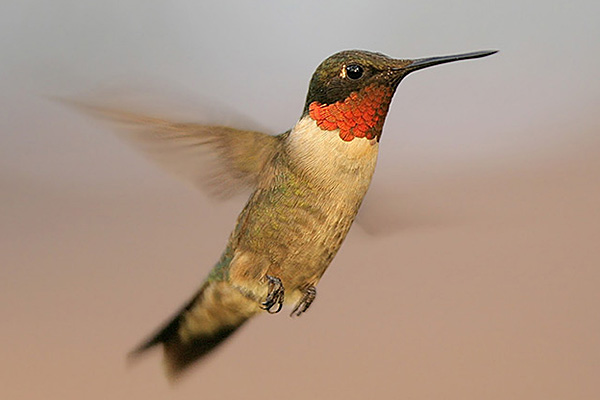
Photograph © Greg Lavaty.
Scientific name: Archilochus colubris
Length: 3.75 inches
Weight: .11 ounces
Wingspan: 4.5 inches
Song: “tik,chickechikchicktiktik”
Ruby-throated Hummingbirds are tiny birds with long, sharp, needle-like beaks. Males are green above and grayish-green below with a broad white semi-collar on their breast and neck. They also have a dark, forked tail, and a glittering orange-red throat.
Females have a pale throat, a small white spot behind each eye, and black and white on the tip of their tail.
This hummingbird species feeds on nectar and tiny insects. It takes nectar from a variety of small flowers and visits hummingbird feeders. They also catch small insects in flight.
Ruby-throated Hummingbirds make small cup nests out of lichen, spider webs, and plant matter. The female constructs the nest on a branch of a tree, often high up.
Ruby-throated Hummingbirds breed in woodland habitats in central and southeastern Canada, and the eastern USA. We often see them in gardens and at hummingbird feeders, especially during migration.
They migrate to Mexico and Central America for the winter.
Key Identifications:
- Tiny greenish bird with a long, straight beak. Males have glittering red throats and females have pale throats and a small white spot behind the eye.
- Takes nectar from flowers, visits hummingbird feeders, and eats tiny insects.
- Makes a small cup nest of lichen, spider webs, and plant matter in a tree.
- The Ruby-throated Hummingbird makes lots of chipping and sputtering calls. They often sound like, “tik,chickechikchicktiktik”.
The Ruby-throated Hummingbird is a tiny bird and the only hummingbird species that breeds east of the Rocky Mountains. They live in wooded habitats and often visit gardens. During migration, many individuals of this migrant species fly hundreds of miles across the waters of the Gulf of Mexico.
Eastern Phoebe
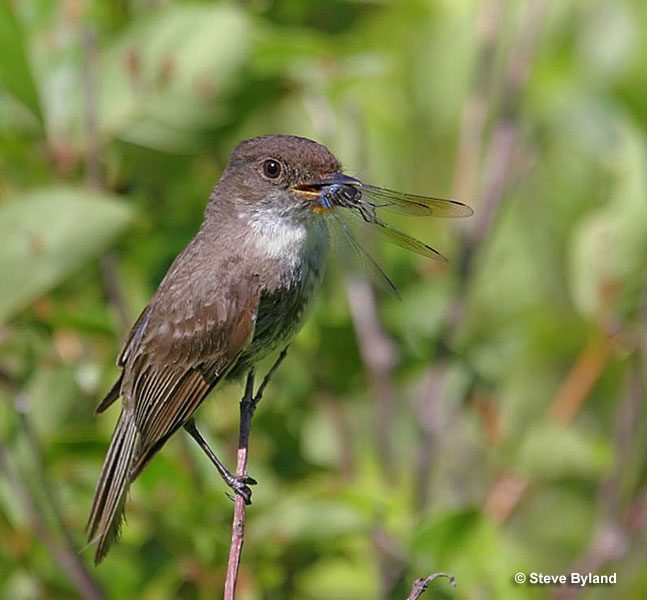
Scientific name: Sayornis phoebe
Length: 7 inches
Weight: .7 ounces
Wingspan: 10.5 inches
Song: “see-BEE! See BIDIT”
The Eastern Phoebe is a small to medium-sized, plain flycatcher that is dark, brownish gray above, and white below. It also has gray on its breast and a long, blackish tail constantly wagged up and down.
This bird also has a blackish head and some pale edging on long, dark wings. Males and females look alike but young birds have pale yellow bellies.
This flycatcher uses its slender beak to snap up insects. It catches them by flying from a perch and snatching them in flight, from foliage while hovering, and from the ground.
We usually see Eastern Phoebes on their own, sitting on low or medium-height perches. They make cup nests of mud, moss, and leaves on rocky outcrops, and under bridges and other structures.
This species breeds not only in Mississippi, but also in woodlands and parks in Canada and the eastern USA, and winters in similar habitats the southeastern USA and Mexico.
Key Identifications:
- Plain, mid-sized flycatcher that is dark brownish-gray above and pale below with some gray on the breast.
- Perches low to mid-height in woodlands and flies out to catch insects. It also feeds on berries in winter.
- Makes a cup nest of mud and vegetation on structures and rocky outcrops.
- Sings a song that sounds like its name, “see-BEE! See BIDIT”.
The Eastern Phoebe is a featureless flycatcher with dark upperparts and pale underparts. It often wags its tail up and down and sallies from perches to catch insects. In 1804, this species became the first bird to be banded in North America when John James Audubon put silvered thread on an Eastern Phoebe’s leg.
Blue-gray Gnatcatcher
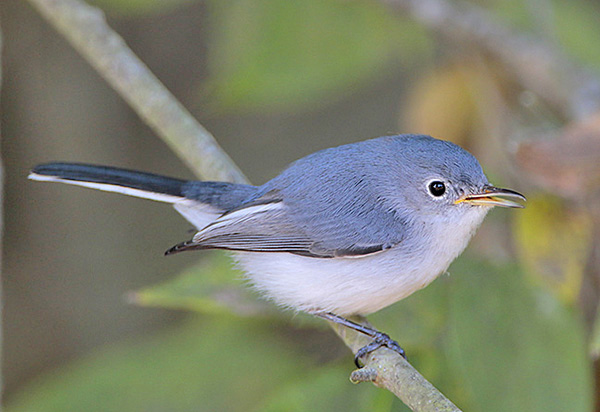
Photograph © Greg Lavaty.
Scientific name: Polioptila caerulea
Length: 4.5 inches
Weight: .21 ounces
Wingspan: 6 inches
Song: “nheah, sip, nheah”
The Blue-gray Gnatcatcher is a tiny, pale gray and white bird with a slender beak. They are blue-gray above and pale gray below with a white eyering. They also have some white edging in their short wings and a longish, black and white tail.
Both sexes look similar except that males have a small black line above their eyes. This species feeds on small insects that it catches in bushes and deciduous trees.
It forages by quickly moving through vegetation and picking bugs from vegetation. They can also fly out to catch insects in flight.
Blue-gray Gnatcatchers make a small cup nest out of lichens and spider webs, usually high in a tree. They live in hardwood forests and are summer residents in parts of southeastern Canada, the eastern USA, and also live in some western states.
They also breed in Mexico and winter from the southern USA to the Caribbean and Honduras.
Key Identifications:
- Tiny pale blue-gray and white bird with a slender beak and longish black and white tail.
- Actively forages for insects.
- Makes a small pale cup nest high in trees.
- Blue-gray Gnatcatchers are quite vocal and make nagging nasal calls. Their most common call sounds like, “nheah, sip, nheah”. They also sing a scratchy song with nasal and tinkling sounds.
The Blue-gray Gnatcatcher lives in hardwood forest habitats. Their nasal calls often reveal their presence as they forage in bushes and high overhead. The nests of these “mini mockingbirds” are so small and camouflaged, they look just like a pale lump on a branch.
Brown Pelican
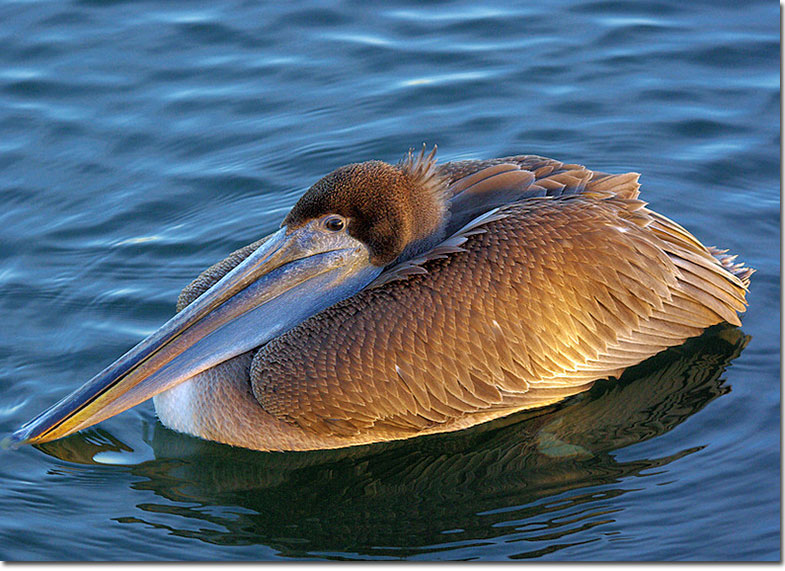
Scientific name: Pelicanus occidentalis
Length: 51 inches
Weight: 8.2 pounds
Wingspan: 79 inches
Song: “rea, reah”
The Brown Pelican is a big, grayish and dark brown pelican with silver highlights on its back and wings. Males and females look alike, have buff on their heads, and a big, pouched beak.
They have dark brown and white necks in summer and all white necks in winter. On the Pacific Coast, Brown Pelicans also have red bill pouches during the breeding season.
Young birds look like dull, gray-brown pelicans with white bellies. These large birds feed on fish in coastal habitats. They catch their food by flying above the water and then folding their wings to dive straight down. After hitting the water with a splash, they snatch the fish with their big, pouched bill.
Brown Pelicans breed in colonies and make large, bulky, platform stick nests on the ground and in trees.
The Brown Pelican lives in coastal waters in many parts of the USA south to the Caribbean and northern South America.
Key Identifications:
- The Brown Pelican is a big, unmistakable, brownish pelican of coastal waters.
- Catches fish after spectacular dives into water.
- Makes big stick nests on the ground and in trees.
- This species is usually quiet but does make some soft, low sounds.
The Brown Pelican is a big, grayish brown pelican that lives in coastal waters. It usually occurs in flocks that forage near shore and needs four pounds of food per day. To protect them while diving into the water, Brown Pelicans have special air sacs.
House Sparrow
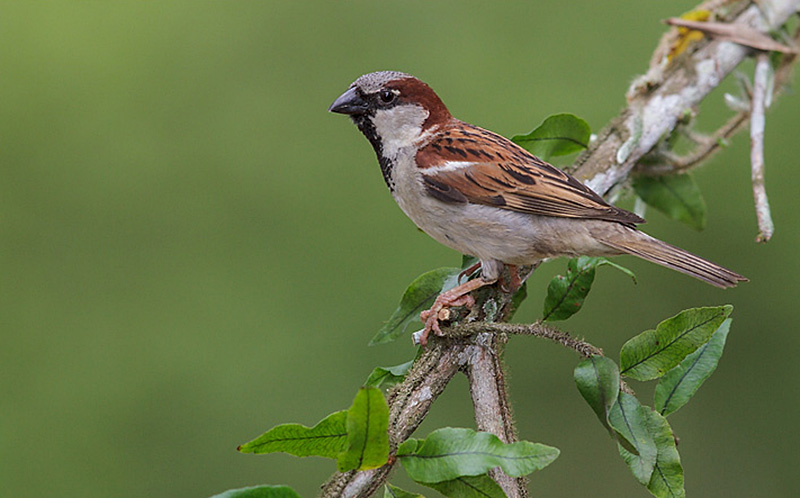
House Sparrow (Passer domesticus) perched on a branch in the Atlantic rainforest of southeast Brazil.
Scientific name: Passer domesticus
Length: 6.25 inches
Weight: .98 ounces
Wingspan: 9.5 inches
Song: “see,chirrup,see,chirrup,see,chirrup”
House Sparrows are small, plump gray and brown birds with conical, finch-like beaks. Males have a gray and rufous head with pale cheeks, and black near their eyes and on their throat.
The rest of their underparts are gray and they have brown, streaked backs with rufous highlights. They also have a white mark in the shoulder of each wing and a grayish rump and tail.
Females are plainer brown and buff, have paler beaks, and buff eyebrows.
House Sparrows feed on seeds, grain, and insects. They are regular visitors to bird feeders and often dominate other smaller species. They also forage on the ground in farmlands, parks, urban areas, and other open situations.
The House Sparrow nests in cavities. When searching for suitable nesting sites, they can kill and remove the eggs and young of smaller species like Eastern Bluebirds.
House Sparrows usually live near people and occur in most of North America, including Mississippi.
Key Identifications:
- Brown and gray sparrow with a bold pattern on its head.
- Feeds on seeds, grain, and insects at feeders and on the ground in urban areas and farmlands.
- Nests in tree cavities, including nest boxes.
- This species is vocal and often makes short chirping calls. Its song is a friendly series of chirping sounds, “see,chirrup,see,chirrup,see,chirrup”.
In many places, the House Sparrow is the common urban sparrow. It occurs in pairs and small groups that forage on sidewalks, in parking lots, farm fields, and other familiar places. This species is one of the very few birds that has evolved to live with people and digest the same grains that we eat.
FAQ
How many bird species are in Mississippi?
426 bird species have been found in Mississippi.
What is the most common bird in Mississippi?
The Northern Cardinal is the most common bird in Mississippi. In 2021, 1031 Northern Cardinals were counted on 29 survey routes in the state.
How many bird species are native to Mississippi?
426 bird species are native to Mississippi. This includes 112 rare visitors to the state, two extinct species, and two others that are probably extinct.


